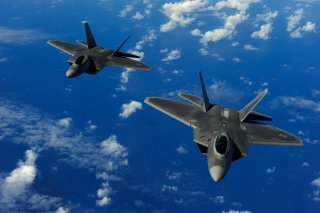How the Air Force Is Taking Hypersonic and AI Research to the Next Level
Key areas of emphasis include hypersonics, artificial intelligence (AI), manned-unmanned teaming, composite materials, stealth technologies, networking, and weapons guidance.
The U.S. Air Force is accelerating efforts to implement various directives related to its 2030 Science & Technology Strategy. The document was first signed in 2019 by former Secretary Heather Wilson and has been steadily pursued by U.S. Air Force weapons developers, scientists, and researchers looking for paradigm-changing new technologies.
The document, which has been supported and refined by service leaders since its release, seeks to optimize areas of scientific focus to ensure the service is prepared as the global threat environment continues to change.
Key areas of emphasis within the strategy include exploring a number of areas such as hypersonics, artificial intelligence (AI), manned-unmanned teaming, composite materials, stealth technologies, networking, and weapons guidance. Regarding hypersonics, one key area of focus, which is now achieving measurable progress, is in an area called “boundary layer phenomenology,” which pertains to the study of “airflow” surrounding a hypersonic projectile. Maj. Gen. Heather Pringle, Commander of the Air Force Research Laboratory (AFRL), told The National Interest about recent breakthroughs in testing and collaboration for boundary layer dynamics. In March 2022, the AFRL conducted an experiment with NASA at the Wallops Flight Facility in what Pringle referred to as a “boundary layer bulk flight experiment.” The test was successful, Pringle said, and helped scientists and weapons developers better understand how to sustain the “trajectory” of a hypersonic weapon in flight in a “turbulent” high-speed environment.
“We were looking at some complex geometries that are different from the systems that we have today. By doing these kinds of experiments, by partnering in these ways, and basic research, then we're informing the shapes of the weapons and the aircraft and the flight systems that we have in the future. So basic research is near and dear to our hearts and something that we have invested in for a long time,” Pringle said.
AI was also cited in the Science and Technology 2030 strategy as a critical area of focus, something Pringle talked about in terms of increasing “reliability” for future operations. She also discussed the value of AI as it operates in tandem with human decisionmakers. Pringle, for example, talked about the crucial role human input can play when it comes to informing or properly directing AI-enabled systems.
“One of the most important underlying tenets of a human-machine relationship is the trust that the human places in the machine and the actions that the machine takes, and is it being transparent enough with a human that to enable that trust and to so that the human knows what actions that machine is going to take,” Pringle said.
Kris Osborn is the defense editor for the National Interest. Osborn previously served at the Pentagon as a Highly Qualified Expert with the Office of the Assistant Secretary of the Army—Acquisition, Logistics & Technology. Osborn has also worked as an anchor and on-air military specialist at national TV networks. He has appeared as a guest military expert on Fox News, MSNBC, The Military Channel, and The History Channel. He also has a Master's Degree in Comparative Literature from Columbia University.
Image: Flickr/U.S. Air Force.

